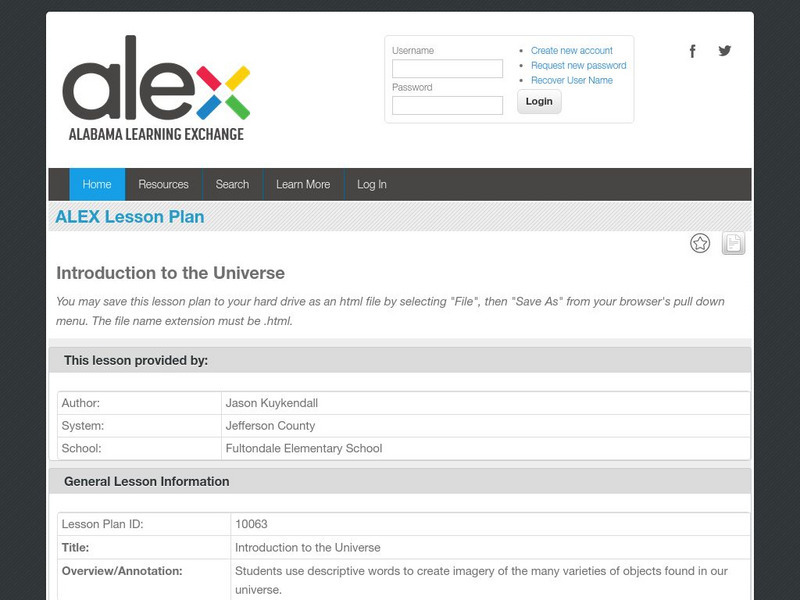Utah State Office of Education
Utah State Office of Education: How Did the Universe and Solar System Develop?
Explore this unit to learn how the universe began. Through illustrations, videos, and classroom activities, gain an understanding of how stars help with the formation of elements.
NASA
Nasa: Nasa's Carl Sagan Fellows to Study Extraterrestrial Worlds
NASA announces the new Carl Sagan Postdoctoral Fellowships in Exoplanet Exploration, created to inspire the next generation of explorers seeking to learn more about planets, and possibly life, around other stars.
E-learning for Kids
E Learning for Kids: Egypt: How Do the Sun, Moon and Earth Revolve Around Each Other?
Omar helps his parents sell things at the market. Join him while he learns about the relationship of the Sun, Moon, and Earth.
American Museum of Natural History
American Museum of Natural History: Ology: Gravity
Flip the card, and learn about gravity.
The Wonder of Science
The Wonder of Science: Ms Ess1 2: Gravity and Motions in Space
Work samples, phenomena, assessment templates, and videos that directly address standard MS-ESS1-2: gravity and motions in space.
Alabama Learning Exchange
Alex: Introduction to the Universe
Students use descriptive words to create imagery of the many varieties of objects found in our universe.
Cool Math
Coolmath: Science Monster: Mercury
A cool fact sheet about Mercury including a place for students to enter their weight on Earth to convert it to what it would be on Mercury.
Other
Observatorio Arval: Clyde Tombaugh
This is a biography page for the American astronomer and discoverer of Pluto, Clyde Tombaugh.
Other
Astrored: Introduccion a La Astronomia
These pages offer you a range of selected resources for you to start learning from scratch Astronomy. This site has five sessions: photo gallery, lessons, interesting articles, videos and a community.
NASA
Nasa: Our Solar System Overview
This site has links to all the planets, providing an overview of the solar system. It also contains information about asteroids, meteors, comets and other features of our solar system.
NASA
Nasa: Goddard Institute for Space Studies: Time on Mars
This site provides a Java-based program called Mars24. You can download this to your computer to keep track of time on Mars.
Discovery Education
Discovery Education: Curriculum Center: Science
The Discovery Channel provides numerous topics that are the most popular science topics taught in upper elementary and middle school. Content is organized by topics (Bacteria, Oceans, Solar System, etc.); all topics include quick facts,...
Other
Hong Kong Space Museum
Besides an introduction to exhibitions and events at the museum, the site provides a guide to stargazing, an astronomy FAQ, space news, virtual tours (see site map) and research resources (including Chinese-English star and constellation...
Utah Education Network
Uen: My Solar System
Students will use a simulation to build their own solar system discovering the relationship between gravity and motion that keeps a planet in orbit.
Utah Education Network
Uen: Forces of the Solar System
Use water balloons to show the effect gravity will have on different sizes of objects in our solar system. Activity also shows how inertia works.
Alabama Learning Exchange
Alex: Planetary Cereal Project
This is a project which would be appropriate to use at the end of a lesson about the solar system. Students will decorate an empty cereal box with information and games showing their comprehension of factual information about an assigned...
Alabama Learning Exchange
Alex: Inner and Outer Planets of the Solar System
In this science instructional activity students will work collaboratively to learn and introduce the eight planets, sizes, characteristics, and their order. They will use size comparisons, research a planet, design a poster and create a...
Alabama Learning Exchange
Alex: Scaling Down the Solar System
In this lesson young scholars will work collaboratively to gain a better understanding of the vastness of space by scaling down the solar system. This lesson plan was created as a result of the Girls Engaged in Math and Science...
Alabama Learning Exchange
Alex: Beyond the Earth Part Ii
A continuation of Beyond the Earth Part I. As part of a unit on the solar system, students will choose a component of the solar system to research. Students may use a variety of resources such as the Internet, books, and reference...
Alabama Learning Exchange
Alex: Beyond the Earth Part I
Students will access prior knowledge of the solar system by completing a graphic organizer. After participating in a teacher lecture and whole group discussion, the students will work in collaborative groups to create a...
Alabama Learning Exchange
Alex: If Earth No Longer Existed. . .
Students will work in cooperative groups to research characteristics of each of the planets in our solar system. Students will design a travel brochure outlining the characteristics of each planet. Each group will make an oral...
Alabama Learning Exchange
Alex: Comets
During this lesson, students have the opportunity to explore comets. By navigating the Internet, viewing a slideshow, and participating in a videoconference with NASA, students will discover what comets are all about.
Alabama Learning Exchange
Alex: Lost in Space a Solar System Study
During this technology based instructional activity, students navigate the Internet to learn interesting information about the solar system. They use the information to complete a worksheet and to create a puzzle or challenge for their...
Alabama Learning Exchange
Alex: Phases of the Moon
This lesson will familiarize students with the phases of the moon. It can be taught in a unit dealing with the solar system. It involves all learning types-kinesthetic, auditory, tactile, and visual.




















